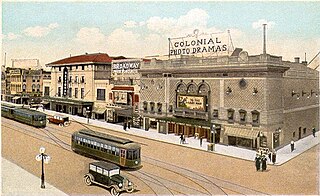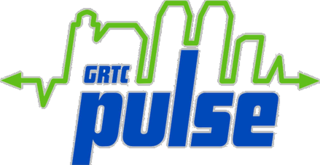Related Research Articles

Richmond is the capital city of the Commonwealth of Virginia in the United States. It is the center of the Richmond Metropolitan Statistical Area and the Greater Richmond Region. Richmond was incorporated in 1742 and has been an independent city since 1871. At the 2010 census, the city's population was 204,214; in 2020, the population had grown to 226,610, making Richmond the fourth-most populous city in Virginia. The Richmond Metropolitan Area has a population of 1,260,029, the third-most populous metro in the state.

Chesterfield County is located just south of Richmond in the Commonwealth of Virginia. The county's borders are primarily defined by the James River to the north and the Appomattox River to the south. Its county seat is Chesterfield Court House.

The Staten Island Railway (SIR) is a rapid transit line in the New York City borough of Staten Island. It is owned by the Staten Island Rapid Transit Operating Authority (SIRTOA), a subsidiary of the Metropolitan Transportation Authority, and operated by the New York City Transit Authority Department of Subways. SIR operates 24 hours a day, seven days a week, providing local service between St. George and Tottenville, along the east side of the island. There is currently only one line on the island, and there is no direct rail link between the SIR and the New York City Subway system, but SIR riders do receive a free transfer to New York City Transit bus and subway lines, and the line is included on official New York City Subway maps. Commuters on the railway typically use the Staten Island Ferry to reach Manhattan. The line is accessible from within the Ferry Terminal, and most of its trains are timed to connect with the ferry. In 2021, the system had a ridership of 2,783,800, or about 12,700 per weekday as of the third quarter of 2022.

Virginia Railway Express (VRE) is a commuter rail service that connects outlying small cities of Northern Virginia to Union Station in Washington, D.C. It operates two lines which run during weekday rush hour only: the Fredericksburg Line from Fredericksburg, Virginia, and the Manassas Line from Broad Run station in Bristow, Virginia. In 2021, the system had a ridership of 530,700, or about 5,600 per weekday as of the third quarter of 2022.

The Greater Richmond Transit Company, known locally as GRTC Transit System, is a local government-owned public service company which operates an urban-suburban bus line based in Richmond, Virginia. In 2021, the system had a ridership of 7,980,600, or about 30,200 per weekday as of the third quarter of 2022.

The Seaboard Air Line Railroad, which styled itself "The Route of Courteous Service," was an American railroad which existed from April 14, 1900, until July 1, 1967, when it merged with the Atlantic Coast Line Railroad, its longtime rival, to form the Seaboard Coast Line Railroad. Predecessor railroads dated from the 1830s and reorganized extensively to rebuild after the American Civil War. The company was headquartered in Norfolk, Virginia, until 1958, when its main offices were relocated to Richmond, Virginia. The Seaboard Air Line Railway Building in Norfolk's historic Freemason District still stands and has been converted into apartments.

The Richmond, Fredericksburg, and Potomac Railroad was a railroad connecting Richmond, Virginia, to Washington, D.C. The track is now the RF&P Subdivision of the CSX Transportation system; the original corporation is no longer a railroad company.

The Richmond and Danville Railroad (R&D) Company was a railroad that operated independently from 1847 until 1894, first in the U.S. state of Virginia, and later on 3,300 miles (5,300 km) of track in nine states.
Algernon Sidney Buford was a Virginian businessman, politician, and lawyer best known for his 22-year presidency of the Richmond and Danville Railroad, during which he was responsible for growing the line from 140 miles in length to 3,000 miles in length. Born in North Carolina to parents of Virginia stock, Buford grew up in Pittsylvania County, Virginia and attended the University of Virginia from 1846 to 1848, graduating with a Bachelor of Law. For the next decade, he practiced law in Pittsylvania and Danville and became the owner and editor of the Danville Register. These occupations were interrupted by a year's service in the Virginia House of Delegates in 1853.

Broad Street is a 15-mile-long (24 km) road located in the independent city of Richmond, Virginia, and adjacent Henrico County. Broad Street is significant to Richmond due to the many commercial establishments that have been built along it throughout Richmond's history. From downtown through miles into the suburbs, the street is largely dedicated to retailing and offices, including regional and neighborhood shopping centers and malls.

The Washington and Old Dominion Railroad was an intrastate short-line railroad located in Northern Virginia, United States. The railroad was a successor to the bankrupt Washington and Old Dominion Railway and to several earlier railroads, the first of which began operating in 1859. The railroad closed in 1968.

Richmond Main Street Station, officially the Main Street Station and Trainshed, is a historic railroad station and office building in Richmond, Virginia. It was built in 1901, and is served by Amtrak. It is also an intermodal station with Richmond's city transit bus services, which are performed by Greater Richmond Transit Company (GRTC). It is colloquially known by people from the city as The Clock Tower. It is a U.S. National Historic Landmark. Main Street Station serves as a secondary train station for Richmond providing limited Amtrak service directly to downtown Richmond. Several Amtrak trains serving the Richmond metropolitan area only stop at the area's primary rail station, Staples Mill Road which is located five miles to the north in Henrico County.

Transportation in the Commonwealth of Virginia is by land, sea and air. Virginia's extensive network of highways and railroads were developed and built over a period almost 400 years, beginning almost immediately after the founding of Jamestown in 1607, and often incorporating old established trails of the Native Americans.

Transportation in Richmond, Virginia and its immediate surroundings include land, sea and air modes. This article includes the independent city and portions of the contiguous counties of Henrico and Chesterfield. While almost all of Henrico County would be considered part of the Richmond area, southern and eastern portions of Chesterfield adjoin the three smaller independent cities of Petersburg, Hopewell, and Colonial Heights, collectively commonly called the Tri-Cities area. A largely rural section of southwestern Chesterfield may be considered not a portion of either suburban area.
Petersburg Area Transit is a bus system for the Petersburg Tri-cities Area. There are twelve color-coded routes that extend to such destinations as Virginia State University, Southpark Mall, and Fort Lee.

The Richmond Union Passenger Railway, in Richmond, Virginia, was the first practical electric trolley (tram) system, and set the pattern for most subsequent electric trolley systems around the world. It is an IEEE milestone in engineering.

The Charlottesville and Albemarle Railway (C&A) was a short electric street railroad operating within the city of Charlottesville, Virginia, United States, during the early 20th century. The line was preceded by several streetcar lines operating both horse-drawn and electric powered cars dating back to 1887. After facing financial difficulties, the predecessor lines were reorganized into the C&A in 1903. The C&A's electric streetcars operated off of an overhead line system that was powered by the railroad's own power plant. The C&A also offered electric power generated by its plant to the city of Charlottesville. During the mid-1910s, the line received numerous upgrades, including the construction of a new power plant on the Rivanna River, a new company headquarters building, expansion of track, and the purchase of new streetcars.

The GRTC Pulse is a bus rapid transit line in Richmond, Virginia, United States. The line runs along Broad Street and Main Street in central Richmond, between The Shops at Willow Lawn and Rockett's Landing. It opened on June 24, 2018, and is the third bus rapid transit service to be constructed in Virginia. The Pulse is the first regional rapid transit system to serve Richmond since 1949.

Willow Lawn station, located at the Shops at Willow Lawn, is a rapid transit station in Richmond, Virginia along the GRTC Pulse bus rapid transit route. It is one of two stations located in Henrico County, and serves the western terminus of the system.
Scott's Addition station is a Richmond, Virginia rapid station site of the GRTC Bus Rapid Transit route.
References
- ↑ Virginia Decisions: A Collection of Virginia Cases Not Officially Reported (1 ed.). 1902. p. 787. Retrieved 20 June 2020.
- ↑ "Our History". ridegrtc.com. GRTC Transit System. Retrieved 20 June 2020.
- ↑ "Our History". ridegrtc.com. GRTC Transit System. Retrieved 20 June 2020.